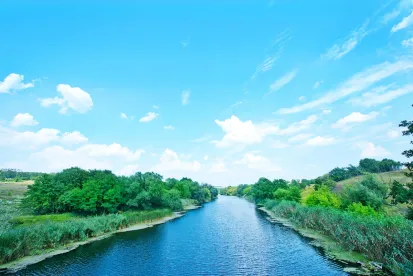It's that song in your head that you can't stop hearing.
On March 20, 2023, the 500-plus page final Revised Definition of "Waters of the United States" ("2023 WOTUS Rule" or "Rule") went into effect, published jointly by the United States Environmental Protection Agency ("EPA") and the United States Army Corps of Engineers ("USACE"). This is the federal government's latest attempt to define the water resources that are protected by federal jurisdiction under the Clean Water Act ("Act"). Like its predecessors—the 2020 Navigable Waters Protection Rule, the 2019 Repeal Rule, and the 2015 Clean Water Rule, the 2023 WOTUS Rule faced legal challenges before its official effective date. And if history is any indication, the 2023 WOTUS Rule will not stand as written. But for now, it is worth considering what this new rule protects.
WOTUS Categories
The 2023 WOTUS Rule sets forth categories of protected waters, as did the government's past attempts to define and interpret "waters of the United States." These previous definitional efforts date to the 1980s and involved years of court rulings in the federal court system. The first category of protected waters in the Rule can be characterized as the Commerce Clause waters: traditional navigable waters, territorial seas, and interstate waters ("Category 1 Waters"). These waters are navigable-in-fact and historically facilitated interstate and foreign commerce. The second WOTUS category is impoundments of waters, such as reservoirs and beaver ponds. The remaining three categories are tributaries, adjacent wetlands, and additional waters (such as lakes, ponds, streams, or wetlands that do not fit in the other four categories). Because the waters in these last three categories are not necessarily navigable-in-fact and are not always readily identifiable, they must meet the jurisdictional standards for protection, discussed below.
Standards for Determining Jurisdiction
To determine jurisdictional protection under the Act for tributaries, adjacent wetlands, and additional waters, the 2023 WOTUS Rule combines two competing approaches from the 2006 United States Supreme Court decision in Rapanos v. U.S. Waters in these three categories are jurisdictional under the Rule, and thus subject to protection, if they satisfy either approach —the Relatively Permanent Test or the Significant Nexus Test.
The Relatively Permanent Test, based on Justice Scalia's plurality opinion in Rapanos, employs a "relatively permanent" test for jurisdiction. To meet the Relatively Permanent Test, the waterbody in question must be: (i) relatively permanent, standing, or continuously flowing and connected to Category 1 Waters; or (ii) a water with a continuous surface connection to such relatively permanent waters or to Category 1 Waters.
The Significant Nexus Test, based on Justice Kennedy's concurring opinion in Rapanos, allows for jurisdiction when there is a significant nexus between a water and its connection to and effect on larger downstream waters; these are waters that Congress fundamentally sought to protect in the Act but never defined. To meet the Significant Nexus Test, the waterbody in question, alone or combined with other waters in the region, must significantly affect the chemical, physical, or biological integrity of Category 1 Waters.
Excluded Waters
As in past rules, the 2023 WOTUS Rule identifies exceptions—some old and some new. Prior converted cropland that satisfies the United States Department of Agriculture's definition of wetlands that were converted to cropland before December 23, 1985, remain outside the Rule's jurisdiction, as do waste treatment systems designed to meet the Act's requirements. Also excluded are: (i) ditches excavated in and draining dry land that do not carry a relatively permanent flow of water; (ii) artificially irrigated areas; (iii) artificial lakes or ponds; (iv) artificial reflecting pools or swimming pools; (v) water-filled depressions incidental to construction activities; and (vi) swales and erosional features that have low volume or infrequent or short duration flow. Groundwater is notably missing from this list of exclusions. Although the EPA and USACE arguably disclaim jurisdiction over groundwater in the preamble to the 2023 WOTUS Rule, it remains to be seen whether the agencies will implement the Rule in a manner that provides jurisdiction over sub-surface groundwater.
In addition to setting forth WOTUS categories, jurisdictional standards, and exceptions, the 2023 WOTUS Rule defines material terms used in the Rule, including "adjacent" and "significantly affect." The Rule also explains how the EPA intends to implement it. The agencies have published guides and fact sheets for various stakeholders, including landowners and the agricultural community, to help the public wade through the voluminous regulation.
Challenges to Survival
The 2023 WOTUS Rule faces both direct and indirect hurdles. Early this year, Texas, Idaho, and aligned industry groups challenged the Rule on statutory and constitutional grounds as beyond the EPA's authority. On the day before the Rule went into effect, a federal district court enjoined the Rule from being implemented in Texas and Idaho while that lawsuit plays out. On similar grounds, industry groups sued the EPA over the Rule in Kentucky, and a coalition of states joined West Virginia to block the Rule from being implemented. Meanwhile, Congress took its own shot at the Rule with a Congressional Review Act joint resolution to overturn the Rule. President Biden vetoed that effort on April 6.
While these direct challenges to the Rule proceed, an earlier lawsuit before the United States Supreme Court, Sackett v. EPA, may have an indirect impact. The lawsuit, which was argued before the Supreme Court in October 2022, questions whether regulators and the Ninth Circuit Court of Appeals properly applied a significant nexus analysis to identify wetlands as "waters of the United States" on the Sacketts' property. The Supreme Court's decision is expected this summer and could affect how the Significant Nexus Test is applied under the Rule.
Conclusion
The implementation of the 2023 WOTUS Rule may affect several activities, most notably land development and agricultural operations. It's important to remember that the Rule does not strictly define wetlands. Rather, it identifies when the USACE has jurisdiction under Section 404 of the Clean Water Act to require a permit for activity impacting waters of the United States. Expect guidance to come from the USACE, but not before the Sackett decision is announced. And if the activity is not regulated by Section 404 of the Act, it still may be regulated by a different permitting program or a state's implementation of different rules under the Act.




 />i
/>i

